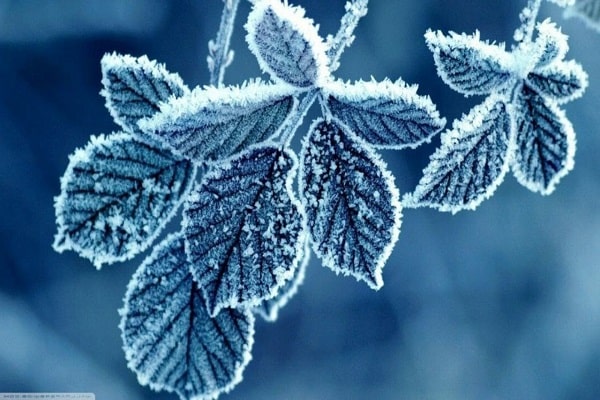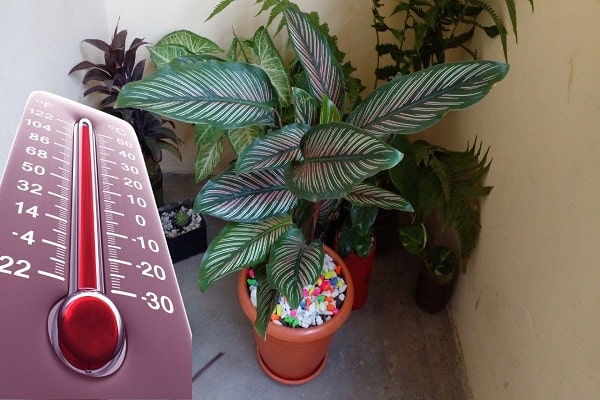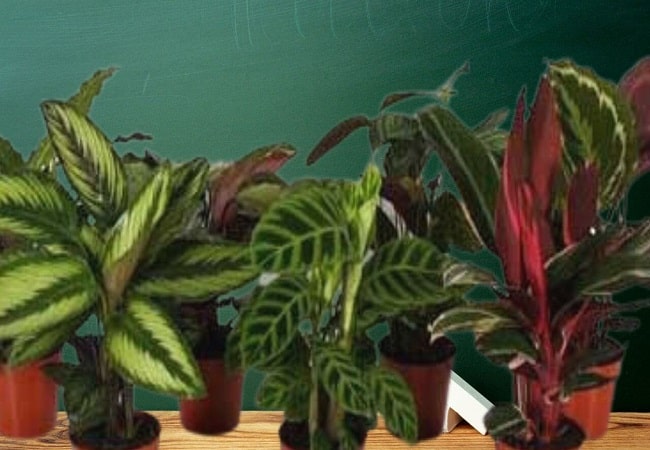Last Updated on April 25, 2023 by Md Deloar Hossain
Calathea is a beautiful plant often found in homes and office buildings. They are known for their striking leaves in various colors and patterns. While Calathea winter care is typically easy to care for, they require special care during winter.
In this blog post, I’ll discuss how to take care of and fix up Calathea in the winter. I will also tell you how to keep your Calathea happy and healthy over the winter.
Quick Navigation
Things You Should Know When Care For Calathea Winter Care

You must remember the following to ensure the winter survival of your Calathea:
- When the topsoil gets dry, you need to water your Calathea.
- To keep the humidity around your Calathea steady, you must put in a humidifier.
- Move your Calathea away from drafts of cold air.
- Make sure your Calathea gets bright, medium sunlight.
- Don’t feed the plant anymore after the fall.
- Check for pests and spray neem oil once a month if you find any.
Calathea Care And Maintenance During The Winter Month

Many calathea plants die in the winter, their owners say. Since winter is the worst time for this plant, even small mistakes can kill it. Most tropical plants, including Calathea, sleep in the winter because the weather is too cold and there isn’t enough light. Since these plants don’t have the right conditions, they stop growing and rest to save energy for the growing season. During the winter, you might need to take care of the plant.
Here are some things you need to do in the winter to care for your Calathea:
Light Needed

Light is the essential part of the Calathea plant during the winter month,
- Your Calathea won’t get the advised 8 to 10 hours of sunlight each day because of the decrease in sunshine’s intensity and length that happens throughout the winter.
- You can move your Calathea outside in the morning if it’s not too cold. The morning sun won’t hurt the plant in any way.
- Suppose it’s too chilly to take your Calathea outside. In that case, you may still provide it with enough light by utilizing artificial lighting.
- Even though the calachea is inactive during the winter, it still needs enough light to keep it from becoming spindly. Because of this, you must remember and provide your calathea with as much light as possible.
Water Needed

Calathea is a plant with particular requirements for watering. Both too moist and too dry soil are undesirable. Keeping the balance is much more difficult in the cold.
- Your Calathea will nevertheless require less water over the winter. Instead of watering it every week, you should only need to do it every two weeks.
- Checking the soil can help you know how much water your calathea needs, especially during these times. This occurs because the soil needs extra time to dry out in the winter.
- The plant will experience less frequent bouts of thirst because there is less light overall. So, water your Calathea less during the winter and less frequently than normal.
- Measuring the water content will help to avoid the soil from drying up. Water it when the top layer begins to feel dry.
Ideal Temperature

The temperature range suitable for Calathea is between 70 and 85 degrees Fahrenheit.
- During the winter, the temperature frequently falls much below 65 degrees Fahrenheit. However, that will not be beneficial to your Calathea in any way. As a result, you need to find a way to tackle this problem while also keeping the plant at a comfortable temperature.
- It would help your Calathea if you didn’t take it outside when it was cold in the winter.
- Your Calathea is placed near a window that faces either east or south.
- The Calathea should be kept away from doors and windows that are opened and closed often.
- Your Calathea should not come into contact with windows that have ice on them.
- Take care not to position your Calathea too close to any heat sources, such as heaters, fireplaces, or radiators.
- You should move your Calathea into full direct sunlight in the morning for three to four hours throughout the winter. It would help if you did this.
Humidity Level

Calatheas thrive in environments with high humidity. Above seventy percent humidity is typical in the areas it calls home. However, you cannot accomplish that while inside.
Your Calathea will thrive as long as you maintain a humidity level that is greater than 50 percent. Nevertheless, the humidity may be lower than that during the winter.
The leaves of your Calathea will get brown and dry if it has not been receiving adequate humidity. However, we are here to provide you with some strategies that you can use to raise the humidity level for your Calathea.
- Put a humidifier in the area close to your Calathea plant.
- You should keep your Calathea in the bathroom if it receives an adequate amount of light there and if the temperatures are appropriate.
- Increase the humidity of your Calathea by placing it on a tray with pebbles.
- You may keep the plant’s environment damp by misting it.
Fertilizer

Only when calanthe is actively growing does it need to be fertilized to help it grow. But as winter gets closer, you should cut back on how much fertilizer you use and then stop using fertilizer altogether during the winter.
Putting fertilizers on your Calathea in the winter won’t help the plant. Instead, it will hurt the plant. If you fertilize the plant in the winter, it won’t take in the nutrients.
If you fertilized your Calathea enough when it was growing, it wouldn’t need any fertilizer in the winter when it’s not growing. You can start the fertilizer process again when summer and spring come around again. Spring and summer are good times to grow things.
Frequently Asked Questions
Do Calatheas Go Dormant During The Winter Months?
You can find much information online about how to take care of Calatheas. One common piece of advice is that they go to sleep in the winter. Let’s go into more depth about what this means.
Calatheas have learned to live in the equatorial rainforest, where the temperature and amount of light are always the same. They don’t have a natural reaction to winter that tells them to find a warm place to stay. Their metabolic rate, however, matches the amount of food and water they can access.
Calatheas don’t grow as much in the winter, when it’s always dark, because they don’t get as much sunlight as needed for their metabolism. This is not always a sign of a full stop, though. Even in winter, your Peacock Plant might surprise you by sending up a few brand-new leaves.
You should be worried if many of your Calathea leaves fall off when the weather turns cold. These trees and bushes don’t lose their leaves yearly and grow new ones as deciduous ones do. When a plant loses all of its leaves at once, it usually has severe cold shock and needs to be taken somewhere warmer.
Is It Possible To Repot A Calathea In The Winter?
You can report a Calathea in the winter if you need to. We don’t think it’s a good idea to repot a Calathea in the winter because the plant will be under more stress then.
If you don’t need it right away, you should repot your Calathea in the spring, which is its growing season, and when it does best. So, the plant can adjust to all the changes with repotting.
In The Winter, Do Calatheas Need Grow Lights?
Grow lights can help if you think your Calathea isn’t getting enough sunlight in the winter.
Calatheas need at least 8 to 10 hours of sunlight each day, which can’t happen in the winter. So you can use grow lights to make up for the time the plant doesn’t get natural light.
Final Thoughts
Calatheas aren’t the biggest fans of winter, but as long as you pay attention to their needs, there’s no reason they can’t stay healthy even in the coldest months. Using the tips in this article, you can keep your plant warm and happy all winter.

My name is Md Robiul Islam and I’m a plant enthusiast. I like to have a garden and research different plants. I also have an interest in environmental science and would like to work in that field in the future.


